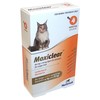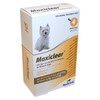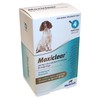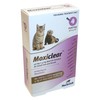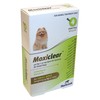Moxiclear
Moxiclear Spot-On Solution has been developed for the treatment and prevention of mixed parasitic infections, including the treatment and prevention of flea infestations, and the prevention of heartworm disease. It contains Imidacloprid and Moxidectin as the active ingredients.
Moxiclear is presented as a clear odourless solution with light opalescence as a spot-on solution in single use pipettes.
Moxiclear Spot-On Solution for Large Cats (4 Pipettes)
£22.82Moxiclear Spot-On Solution is a broad spectrum endectocide developed for the treatment and prevention of mixed parasitic infections in cats weighing between 4kg and 8kg. Presented in...[More info]
Moxiclear Spot-On Solution for Medium Dogs (4 Pipettes)
£25.39Moxiclear Spot-On Solution is a broad spectrum endectocide developed for the treatment and prevention of mixed parasitic infections in medium dogs weighing between 4kg and 10kg. Presented...[More info]
Moxiclear Spot On Solution for Large Dogs (4 Pipettes)
£30.82Moxiclear Spot-On Solution is a broad spectrum endectocide developed for the treatment and prevention of mixed parasitic infections in large dogs weighing between 10kg and 25kg. Presented...[More info]
Moxiclear Spot-On Solution for Small Cats and Ferrets (4 Pipettes)
£21.88Moxiclear Spot-On Solution is a broad spectrum endectocide developed for the treatment and prevention of mixed parasitic infections in cats weighing 4kg or less, and ferrets. Presented in...[More info]
Moxiclear Spot On Solution for Very Large Dogs (4 Pipettes)
£39.40Moxiclear Spot-On Solution is a broad spectrum endectocide developed for the treatment and prevention of mixed parasitic infections in large dogs weighing between 25kg and 40kg. Presented...[More info]
Moxiclear Spot-On Solution for Small Dogs (4 Pipettes)
£22.78Moxiclear Spot-On Solution is a broad spectrum endectocide developed for the treatment and prevention of mixed parasitic infections in small dogs weighing 4kg or less. Presented in...[More info]
Contraindications
Do not use in puppies under 7 weeks of age.
Do not use in cases of hypersensitivity to the active substances or to any of the excipients.
Do not use in dogs classified as Class 4 for heartworm disease as the safety of the product has not been evaluated in this animal group.
For cats, the corresponding "Moxiclear for cat" product, which contains 100 mg/ml imidacloprid and 10 mg/ml moxidectin, must be used.
For ferrets: Do not use Moxiclear for dogs. Only "Moxiclear for small cats and ferrets" (0.4 ml) must be used.
Do not use on canaries.
Special precautions for use in animals
The treatment of animals weighing less than 1 kg should be based on a risk-benefit assessment.
There is limited experience on the use of the product in sick and debilitated animals, thus the product should only be used based on a risk-benefit assessment for these animals.
Care should be taken that the contents of the pipette or the applied dose does not come into contact with the eyes or mouth of the recipient and/or other animals. Do not allow recently treated animals to groom each other. When the product is applied in 3 to 4 separate spots (see section 4.9), specific care should be taken to prevent the animal licking the application sites.
This product contains moxidectin (a macrocyclic lactone), therefore special care should be taken with Collies, Old English Sheepdogs and related breeds or crossbreeds, to correctly administer the product as described under section 4.9; in particular, oral uptake by the recipient and/or other animals in close contact should be prevented.
The product should not enter water courses as it has harmful effects on aquatic organisms: moxidectin is highly toxic to aquatic organisms. Dogs should not be allowed to swim in surface waters for 4 days after treatment.
The safety of the product has only been evaluated in dogs classified as either Class 1 or 2 for heartworm disease in laboratory studies and in a few Class 3 dogs in a field study. Therefore the use in dogs with obvious or severe symptoms of the disease should be based on a careful benefit risk assessment by the treating veterinarian.
Although experimental overdosage studies have shown that the product may be safely administered to dogs infected with adult heartworms, it has no therapeutic effect against adult Dirofilaria immitis. It is therefore recommended that all dogs 6 months of age or more, living in areas endemic for heartworm, should be tested for existing adult heartworm infection before being treated with the product. At the discretion of the veterinarian, infected dogs should be treated with an adulticide to remove adult heartworms. The safety of the product has not been evaluated when administered on the same day as an adulticide.
Imidacloprid is toxic for birds, especially canaries.
Special precautions to be taken by the person administering the veterinary medicinal product to animals
Avoid contact with skin, eyes or mouth.
Do not eat, drink or smoke during application. Wash hands thoroughly after use.
After application do not stroke or groom animals until the application site is dry.
In case of accidental spillage onto skin, wash off immediately with soap and water.
People with a known hypersensitivity to benzyl alcohol, imidacloprid or moxidectin should administer the product with caution. In very rare cases the product may cause skin sensitisation or transient skin reactions (for example numbness, irritation or burning/tingling sensation).
In very rare cases the product may cause respiratory irritation in sensitive individuals.
If the product accidentally gets into eyes, they should be thoroughly flushed with water.
If skin or eye symptoms persist, or the product is accidentally swallowed, seek medical advice immediately and show the package leaflet or label to the physician.
Do not ingest. In case of accidental ingestion, seek medical advice immediately and show the package leaflet or the label to the physician.
In order to prevent children from getting access to pipettes, keep the pipette in the original packaging until ready for use and dispose of used pipettes immediately.
Treated animals should not be handled until the application site is dry, and children should not be allowed to play with treated animals until the application site is dry. It is therefore recommended that animals are not treated during the day, but should be treated during the early evening, and that recently treated animals are not allowed to sleep with owners, especially children.
The solvent in the product may stain or damage certain materials including leather, fabrics, plastics and finished surfaces. Allow the application site to dry before permitting contact with such materials.
Adverse reactions (frequency and seriousness)
Use of the product may result in transient pruritus in dogs. On rare occasions greasy hair, erythema and vomiting can occur. These signs disappear without further treatment. The product may, in rare cases, cause local hypersensitivity reactions. If the animal licks the application site after treatment, neurological signs (most of which are transient) may be observed in very rare cases.
see section, "Withdrawal period(s)"
The product tastes bitter. Salivation may occasionally occur if the animal licks the application site immediately after treatment. This is not a sign of intoxication and disappears within some minutes without treatment. Correct application will iarrhea licking of the application sites.
The product may in very rare cases cause at the application site a sensation resulting in transient behavioural changes such as lethargy, agitation, and inappetence.
A field study has shown that in heartworm positive dogs with microfilaraemia there is a risk of severe respiratory signs (coughing, tachypnea and dyspnea) that may require prompt veterinary treatment. In the study these reactions were common (seen in 2 of 106 treated dogs). Gastrointestinal signs (vomiting, iarrhea, inappetence) and lethargy are also common adverse reactions following treatment in such dogs.
The frequency of adverse reactions is defined using the following convention:
•very common (more than 1 in 10 animals displaying adverse reaction(s))
•common (more than 1 but less than 10 animals in 100 animals treated)
•uncommon (more than 1 but less than 10 animals in 1,000 animals treated)
•rare (more than 1 but less than 10 animals in 10,000 animals treated)
•very rare (less than 1 animal in 10,000 animals treated, including isolated reports).
Use during pregnancy, lactation or lay
The safety of the veterinary medicinal product has not been established during pregnancy and lactation. Laboratory studies with either imidacloprid or moxidectin in rats and rabbits have not produced any evidence of teratogenic, foetotoxic or maternotoxic effects.
Use only accordingly to the benefit-risk assessment by the responsible veterinarian.
Interaction with other medicinal products and other forms of interaction
During treatment with the product no other antiparasitic macrocyclic lactone should be administered. No interactions between the product and routinely used veterinary medicinal products or medical or surgical procedures have been observed.
Safety of the product when administered on the same day as an adulticide to remove adult heartworms has not been evaluated.
Amounts to be administered and administration route
Dosage schedule:
The recommended minimum doses are 10 mg/kg bodyweight imidacloprid and 2.5 mg/kg bodyweight moxidectin, equivalent to 0.1 ml/kg bodyweight the product for dogs.
The treatment schedule should be based on individual veterinary diagnosis and on the local epidemiological situation.
Flea treatment and prevention (Ctenocephalides felis)
One treatment prevents future flea infestation for 4 weeks. Existing pupae in the environment may emerge for 6 weeks or longer after treatment is initiated, depending upon climatic conditions. Therefore, it may be necessary to combine the product treatment with environmental treatments aimed at breaking the flea life cycle in the surroundings. This can result in a more rapid reduction in the household flea population. The product should be administered at monthly intervals when used as part of a treatment strategy for flea allergy dermatitis.
Treatment of biting lice (Trichodectes canis)
A single dose should be administered. A further veterinary examination 30 days after treatment is recommended as some animals may require a second treatment.
Treatment of ear mite infestation (Otodectes cynotis)
A single dose of the product should be administered. Loose debris should be gently removed from the external ear canal at each treatment. A further veterinary examination 30 days after treatment is recommended as some animals may require a second treatment. Do not apply directly to the ear canal.
Treatment of sarcoptic mange (caused by Sarcoptes scabiei var. canis)
A single dose should be administered twice 4 weeks apart.
Prevention of heartworm disease (D. immitis) and cutaneous dirofilariosis (D. repens)
Dogs in areas endemic for heartworm, or those which have travelled to endemic areas, may be infected with adult heartworms. Therefore prior to treatment with the product, the advice provided in section 4.5 should be considered.
For prevention of heartworm disease and cutaneous dirofilariosis, the product must be applied at regular monthly intervals during the time of the year when mosquitoes (the intermediate hosts which carry and transmit D. immitis and D. repens larvae) are present. The product may be administered throughout the year or at least 1 month before the first expected exposure to mosquitoes. Treatment should continue at regular monthly intervals until 1 month after the last exposure to mosquitoes. To establish a treatment routine, it is recommended that the same day or date be used each month. When replacing another heartworm preventative product in a heartworm prevention programme, the first treatment with the product must be given within 1 month of the last dose of the former medication.
In non-endemic areas there should be no risk of dogs having heartworm. Therefore they can be treated without special precautions.
Treatment of microfilariae (D. immitis)
The product should be administered monthly for two consecutive months.
Treatment of cutaneous dirofilariosis (skin worm) (adult stages of Dirofilaria repens)
The product should be administered monthly for six consecutive months.
Reduction of microfilariae ( D. repens)
The product should be administered monthly for four consecutive months. Efficacy against adult worms has not been shown. Adult worms may continue to produce microfilariae.
Treatment and prevention of Angiostrongylus vasorum
A single dose should be administered. A further veterinary examination 30 days after treatment is recommended as some animals may require a second treatment.
In endemic areas regular 4 weekly application will prevent angiostrongylosis and patent infection with Angiostrongylus vasorum.
Treatment of Crenosoma vulpis
A single dose should be administered.
Prevention of Spirocerca lupi:
The product should be administered monthly.
Roundworm, hookworm and whipworm treatment (Toxocara canis, Ancylostoma caninum, Uncinaria stenocephala, Toxascaris leonina and Trichuris vulpis).
In areas endemic for heartworm, monthly treatment may significantly reduce the risk of re-infection caused by the respective round-, hook- and whipworms. In areas non-endemic for heartworm, the product can be used as part of a seasonal prevention programme against fleas and gastrointestinal nematodes.
Studies have shown that monthly treatment of dogs will prevent infections caused by Uncinaria stenocephala.
Method of administration
For external use only. Do not remove the pipette from the sachet until ready to use.
Remove the pipette from the outer sachet using scissors or fold along diagonal line to expose nick; tear back at nick.
Hold the pipette upright. Tap the narrow part of the pipette to ensure the contents remain within the main body of the pipette. Twist or snap back the tip.
For dogs up to 25 kg:
With the dog in a standing position, part the coat between the shoulder blades until the skin is visible. Wherever possible apply to undamaged skin. Place the tip of the pipette on the skin and squeeze the pipette firmly several times to empty its contents directly onto the skin.
For dogs of more than 25 kg:
For easy application the dog should be standing. The entire contents of the pipette should be applied evenly as 3 or 4 spots along the top of the back, from between the shoulders to the base of the tail. At each spot, part the coat until the skin is visible. Wherever possible apply to undamaged skin. Place the tip of the pipette on the skin and gently squeeze the pipette to expel a portion of its contents directly onto the skin. Do not apply an excessive amount of solution at any one spot, as that could cause some of the product to run down the animal's side.
Overdose (symptoms, emergency procedures, antidotes), if necessary
Up to 10 times the recommended dose was tolerated in adult dogs with no evidence of adverse effects or undesirable clinical signs. Five times the recommended minimum dose applied at weekly intervals for 17 weeks was investigated in dogs aged over 6 months and tolerated with no evidence of adverse effects or undesirable clinical signs.
The product was administered to puppies at up to 5 times the recommended dose, every 2 weeks for 6 treatments, and there were no serious safety concerns. Transient mydriasis, salivation, vomiting and transient rapid respiration were observed.
After accidental oral ingestion or overdose, neurological signs (most of which are transient) such as ataxia, Generalized tremors, ocular signs (dilated pupils, little pupillary reflex, nystagmus), abnormal respiration, salivation and vomiting may occur in very rare cases.
Ivermectin-sensitive Collie dogs tolerated up to 5 times the recommended dose repeated at monthly intervals without any adverse effects, but the safety of application at weekly intervals has not been investigated in ivermectin-sensitive Collie dogs. When 40 % of the unit dose was given orally, severe neurological signs were observed. Oral administration of 10 % of the recommended dose produced no adverse effects.
Dogs infected with adult heartworms tolerated up to 5 times the recommended dose, every 2 weeks for 3 treatments, without any adverse effects.
In case of accidental oral uptake, symptomatic treatment should be administered. There is no known specific antidote. The use of activated charcoal may be beneficial.
Withdrawal period(s)
Not applicable.
